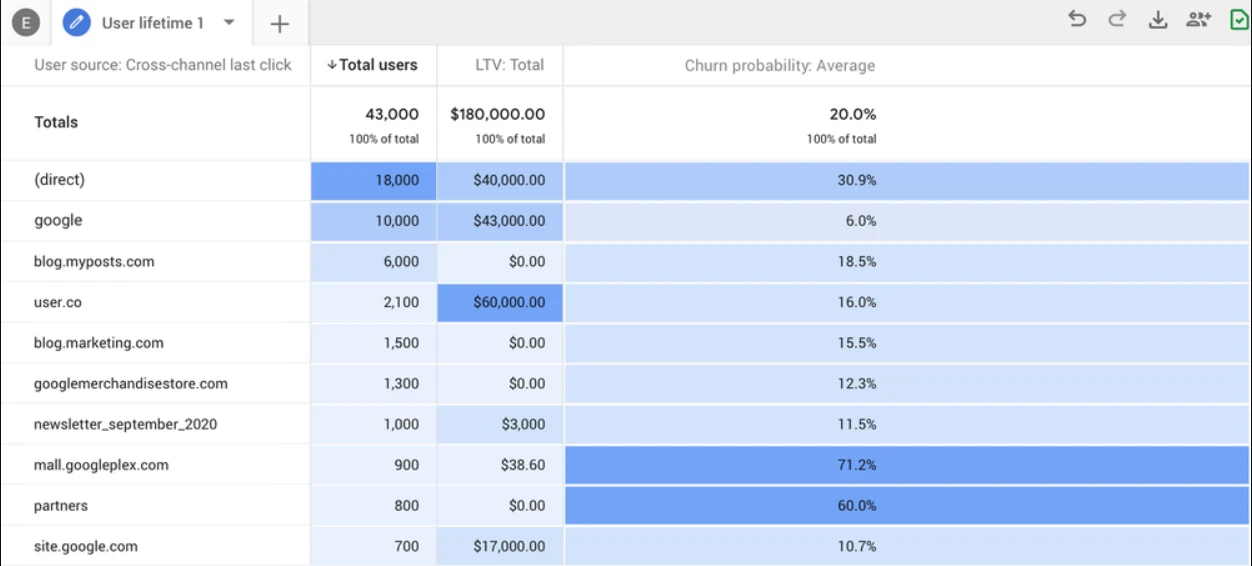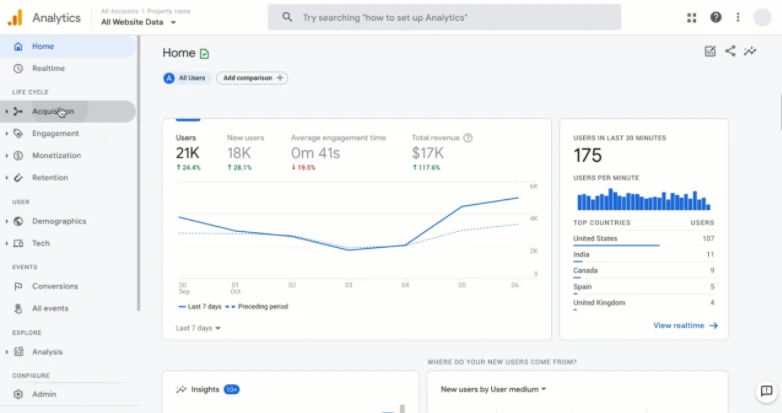Google Analytics 4: What are the new features?

Google Analytics 4: A Comprehensive Guide
As commerce continues to increasingly pivot toward the digital realm, data collection and analysis is becoming even more integral to business success. In this article, we discuss Google Analytics 4, its new features, and what it means for your digital marketing efforts.
History of Google Analytics
Since 2005, Google Analytics has enabled businesses to measure the performance of their digital marketing efforts by helping them track vast amounts of data. Here’s a brief rundown of how this incredible tool was birthed, and how it has evolved since.
2005
The analytics revolution began when Google acquired Urchin Software Corporation in April of 2005. Seven months later, Google Analytics was rolled out.
2006
In August of 2006, the platform was officially made available to all Google users.
2009
Google provides users with Asynchronous - a tracking code snippet that serves as a more accurate way to track your website.
2011
In September of 2011, real-time analytics was launched. This feature allowed you to see users on your site in real-time.
2012
Google Tag Manager is launched. This feature helps users organize analytics, advertising, and other tags.
2014
Universal begins beta testing and is made accessible to users who want to upgrade.
2015
Shortly after, Universal is out of beta - offering incredibly useful features that changed the way data is collected and organized in users’ Google Analytics accounts.
2016
Google announces Google Data Studio - this lets users connect to all their marketing data and turn those into visual, informative reports that make analytics easier to understand. Data Studio also allowed users to easily customize and share reports.
Google Analytics Usage Stats
Here are a few numbers to give you a glimpse of how Google Analytics has impacted our world today.
- According to Built With, they know of 28,832,505 live websites using Google Analytics, which is estimated to be 8.4% of the entire internet.

- While that may seem like a small share, 69.5% of Quantcast’s Top 10,000 sites (based on traffic) use Google Analytics.
- Additionally, 54.6% of the top million websites it tracks use Google Analytics.
It’s important to note that because Google has been tight-lipped about their own numbers, the services mentioned above use different methodologies and track different analytics tools to come up with their estimates. Nonetheless, no one doubts that Google Analytics is, far and away, the most popular web analytics software used today.
Google Analytics 4 Explained
Even before the pandemic, an increasing number of businesses have pivoted their efforts online. And with the digital landscape becoming more and more competitive by the day, millions of businesses have turned to Google Analytics to understand their customers and get insights that can help them create better experiences for them. Additionally, having a clear understanding of analytics allows businesses to make every dollar count.
But with consumer privacy and how their data are being used becoming a hot topic for the past few years, Google has made moves to make their approach to analytics keep pace with consumer behavior and new industry standards.
According to Vidhya Srinivasan, Vice President of Google’s Measurement, Analytics, and Buying Platforms, they’ve created a more intelligent Google Analytics built on the foundation of the App + Web property they introduced in 2019. Google Analytics 4 has machine learning at its core to automatically surface helpful insights designed to give users a complete understanding of their customers across devices and platforms.
The privacy-focused design allows users to rely on analytics to get better ROI even as industry changes such as restrictions on cookies and identifiers create gaps in the data.
Google Analytics 4 Features
Smarter Insights = Better Marketing Decisions and ROI
Srinivasan points out that by applying Google’s advanced machine learning models, Google Analytics 4 can automatically alert you to significant trends in your data such as products experiencing increased demand because of emerging customer needs.
These types of insights can help you anticipate future actions your customers could take. It can, for example, calculate churn probability so you can more efficiently invest in retaining customers - even at a time like this when there is increased pressure on marketing budgets. So whether it’s through creating more relevant content or verifying email addresses of your subscribers, your actions are fully informed.
The new Google Analytics is adding more predictive metrics (such as potential revenue from specific segments). This allows you to take action to reach higher-value customers and better understand why some customers are likely to spend more than others.

Smarter Advertising
The new analytics platform also provides new integrations across Google’s marketing products. With the deeper integration with “how to run Google Ads” to attract more clients, for example, it lets you create audiences that can reach your customers with more relevant and helpful experiences wherever they engage with your business.
Additionally, you can now address longtime advertiser requests. By measuring app and web interactions together, it can, for example, include conversions from YouTube-engaged views that happen in-app and on the web in its reports.
When you’re able to see conversions from YouTube videos alongside those from other platforms like Google, non-Google paid channels, organic ones like Google Search, social media, email and other prospecting tools, you’re able to better understand the combined impact of your marketing efforts and unlock potential growth hacking strategies.
Complete Understanding of How Customers Interact with your Business
Previous versions of Google Analytics gave users data fragmented by device or platform. Google Analytics 4 provides you with customer-centric measurement by using multiple identity spaces such as marketer-provided user IDs, and unique Google signals from users opted into ads personalization to give you a holistic view of how your customers interact with your business.
For instance, you can see if your customers discover your business on social then visit your website to complete their purchase there.
Additionally, you get a better understanding of the entire customer lifecycle. In this ever-changing world, this is crucial to help you make real-time decisions in order to keep and win over new customers. Using your feedback, you can see which channels are driving new customers in the user acquisition report. You can then use the engagement and retention reports to see and understand the actions customers take, and whether they stick with you after conversion.

Long-Term Solutions
Because users are being provided with smarter insights, you can fully invest in your digital marketing efforts knowing you’ll be ready for the changes that will come. These include SEO agility, rising consumer expectations, producing quality content, regulatory developments, and technology standards for user privacy.
The new approach to data controls, for example, allows you to better manage how you collect, retain, and use for Analytics data. Meanwhile, more granular controls for ads personalization allow you to choose when to use your data for ads optimization and when to limit your data use.
This agile approach to measurement is essential to better navigate the future filled with uncertainty.
Important to Note
Keep in mind that Google Analytics 4 will not immediately enhance the reporting of most online merchants. It is designed to help companies that:
- Have an app
- Have a SaaS business model
- Are interested in advanced remarketing
But even if you do not have the above, all merchants are encouraged to create a Google Analytics 4 property to be able to benefit from updated reporting and enhanced features that are still to come such as “embedded analytics”.

Image source: https://www.practicalecommerce.com/introduction-to-google-analytics-4
Best Tools for Google Analytics
#1. Nightwatch
This tool aggregates data from all major SEO and search sources from Google Analytics, Search Console, Keyword Planner, among other popular sources, to turn it into beautiful, easy to export reports for clients.
#2. Google Tag Assistant
This debugging tool is a Chrome extension that checks whether Google Analytics awards conversion tracking. Google Tag Manager, among other tools, are working properly. It enables you to troubleshoot issues you may have with Google Analytics in real-time and address them immediately.
#3. Google Analytics URL Builder
This tool allows you to create a campaign URL based on the current URL and use automated reporting tools that track the progress of the URL. This can be used to track which promotions get traffic to the site.
#4. Google Analytics Table Booster
This Chrome extension enhances the data grid of Google Analytics by providing three types of visualization. Each row in the data grid can use different types of visualization, making it one of the best ways to evaluate the performance of the data.
Final Words
As noted by Srinivasan, Google Analytics 4 is now the default experience for new properties and where Google is investing in future investments. Creating a new Google Analytics 4 property alongside your existing properties will allow you to start gathering data while benefiting from the latest innovations rolled out by Google.
How is your current analytics setup? How do you think Google Analytics 4 can enhance the way you use and analyze data? Sound off in the comments below.
Author Bio
Aaron Chichioco is the chief content officer (CCO) and one of the web designers of Design Doxa. Aside from his expertise on web/mobile design and development, he also has years of experience in digital marketing, branding, customer service, eCommerce and business management as well. For more information about Aaron, visit http://designdoxa.com/about-us/.
Newsletter
Subscribe to our newsletter
Join our newsletter to be the first to access Nightwatch's cutting-edge tools, exclusive blog updates, and fresh wiki insights. Transform your online presence today!
